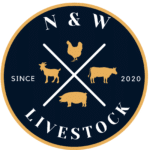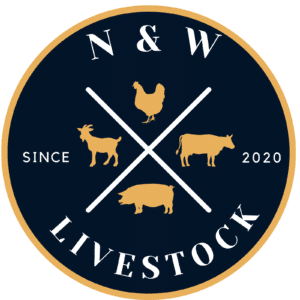23 JAN 2023 – Written by ParaBoss
Worms are active all year round. But some worms really love warm wet weather. This means that as the weather warms up in summer, worm burdens build up inside our stock, as well as on their pastures. This year’s wet start to summer has led to overwhelming contamination of paddocks in many areas of Australia.
What worms?
Different worms have different preferences for temperature and rainfall.
Barbers’s pole worms (sheep and goats have Haemonchus contortus, while cattle have H. placei) have an ideal development temperature of 27.5°C, but also need wet conditions, e.g. 2 days rainfall, for the eggs to hatch and develop. Once the eggs have hatched however, the third stage larvae are quite resilient and will survive months on pasture. This means that development of infective larvae on pastures peaks in wet summers.
In cattle, small intestinal worms (Cooperia) also like warm conditions, with larval development not starting until 10°C and speeding up at temperatures around 30°C. Ideal humidity (at ground level) is around 65%. Cooperia has highest numbers of larvae on pasture in summer and autumn.
Black scour worms (Trichostrongylus colubriformis) also like warm weather, with highest development of eggs to larvae at 27.0°C. They will continue to infest sheep and goats throughout the year.
Strategy and tactics
Summer worm problems in livestock need to be approached according to priority.
- The most important thing is to stop animals from dying.
- The second priority to is to keep animals from getting dangerous worm burdens.
- Third priority is to set up systems that reduce risk of worms and maximise productivity.
- Preventing stock from dying
Dead sheep or goats may be the first sign of a catastrophic summer worm problem. Scours and dags will often be absent over the summer months, as barber’s pole worms are more likely to lead to dry hard pellets. Even sheep and goats in good condition can succumb very quickly to worm infections. Cattle are generally more resilient, but in recent months several cases of deaths due to barber’s pole worms have been reported.
A veterinary post-mortem examination will confirm the presence of worms in the abomasum or small intestine, as well as reveal other possible causes of death.

The other tell-tale signs of summer worm infections are:
a) Pale colour of gums or conjunctiva (usually pink, but will become pale or white due to anaemia)
b) Unable to walk- animals pant and lie down when mustered
c) Bottle jaw- soft accumulation of fluid under the jaw
d) High worm egg counts- often thousands of eggs per gram
Sheep and goats with high burdens of barber’s pole worms are at high risk of dying and need to be handled very carefully. Where possible, avoid mustering long distances and instead set up portable yards in paddocks close to the mob. Muster slowly, preferably in the cool of the day and handle gently.
Treat with an effective drench, based on your drench test results. Where these are not available, use one of the ‘new’ drenches containing monepantel or derquantel. See the WormBoss products search tool for details.
Open gates and allow animals to return to their paddocks at a slow walking pace.
Monitor stock over the next few days to ensure they are improving in condition. It can take two to three weeks for animals to recover from severe anaemia which is typical of barber’s pole worm infections. Damage to the intestines from scour worms will also take up to a month to repair. Severely-affected animals may need to be kept in a hospital pen with shade, supplementary feed and water for a week or two to allow them time to recover.
2. Keep animals from getting dangerous worm burdens
The most susceptible animals on your property are young stock (weaners and yearlings) and pregnant females. Entire males (rams, bucks, bulls) are also often at high risk. Priority should be given to providing the lowest risk pastures for these groups.
Paddocks with a history of carrying stock with high worm burdens pose a high risk. These should be avoided until they have been cleared of high worm larval contamination.

This can be done by:
- Spelling- see wormboss.com.au for clear guidelines about how long to spell paddocks under different conditions
- Barbervax– in sheep will reduce worm egg output from barber’s pole worms. Immunity to worms occurs after the 3rd injection, so this is not a ‘quick-fix’ solution.
- Low stocking rates- allow stock to graze larger paddocks that are less likely to be picking up contamination with worm larvae
- Making hay, cultivating or grazing with non-susceptible stock (e.g. dry cattle, wethers, non-pregnant ewes, animals treated with long-acting drenches)
- Using long-acting treatments– moxidectin injections and closantel provide prolonged protection from barber’s pole worms. These need to be used with care as the protection period is shortened in most areas due to resistance. Primer and exit drenches are required.
- Give supplementary feed (hay, concentrates). This has 2 benefits- it provides extra nutrition that allows animals to fight off worm infections and it is a feed source that is not contaminated by worm larvae. A droughtlot can be used if necessary.
- Goats should be allowed to have ‘browse’ (feed from bushes or grasses with a high sward) so they avoid picking up worm larvae, which are mainly in the bottom 5cm of the grass sward.

3. Set up systems that reduce risk of worms
Once the immediate risk to the health of stock is addressed, the next priority is to set up systems that allow animals to graze, grow and reproduce to their maximum potential.
- Annual program- see WormBoss for details of an annual program specific to your region. These are available for goats, sheep and cattle.
- Use an advisor- your local WormBoss accredited advisor will help set up monitoring, paddock rotations and strategic treatments that will minimise risk to your stock
- Drench test– resistance is common in sheep, cattle and goat worms, so find out which drenches (anthelmintics) work and which ones don’t
- Monitor- do regular worm egg counts and monitor bodyweights, body condition score and eye colour (FAMACHA score) to predict when animals are going to need an intervention, rather than reacting to a crisis
- Upskill- learn about livestock parasites by reading through the fascinating pages on the WormBoss.com.au website.



